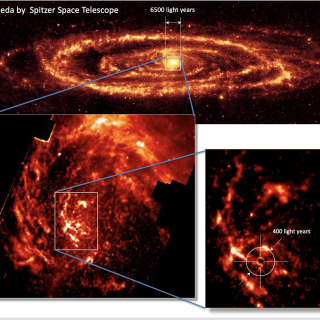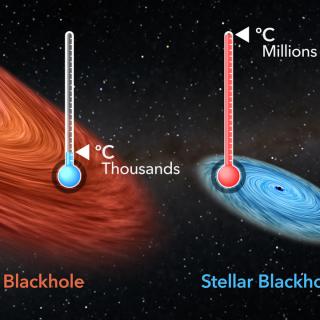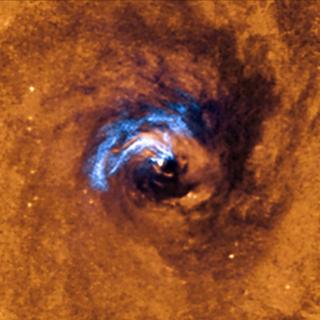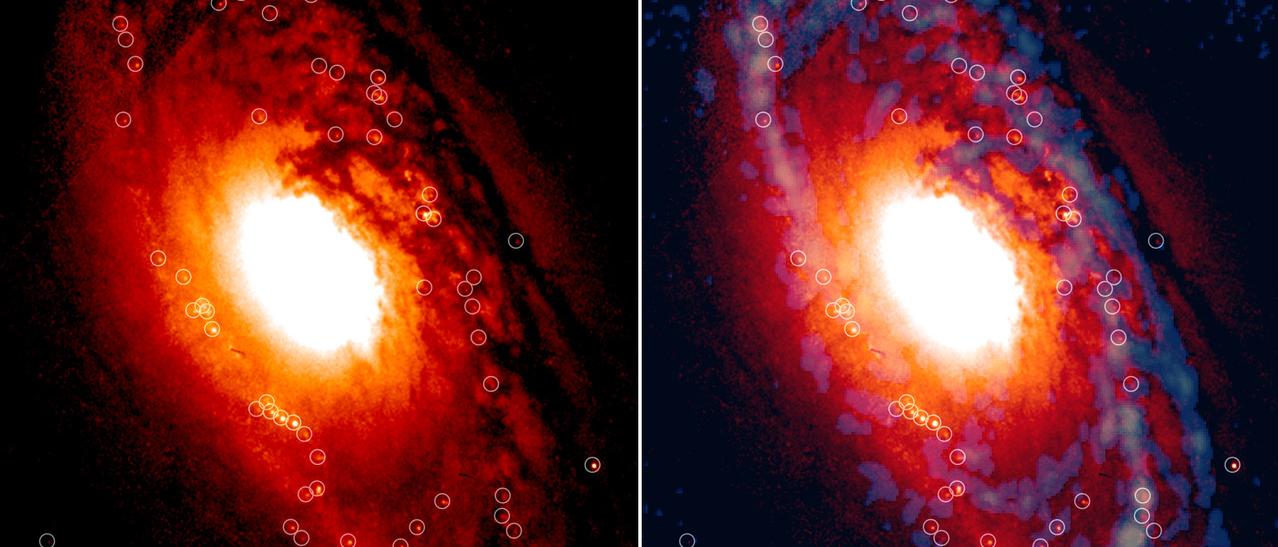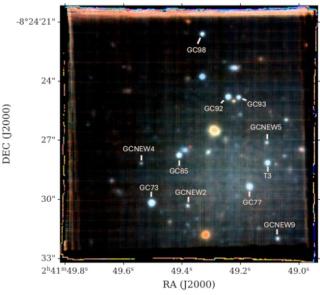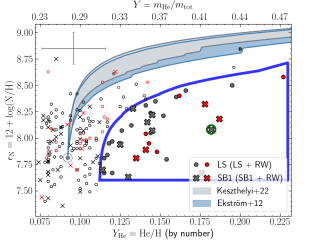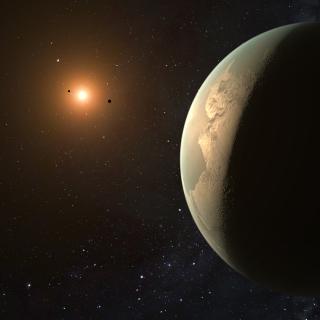The two images show the central region of the old galaxy NGC 1386. On the left is the galaxy in visible light, taken with the Hubble Space Telescope. On the right is the same view, but combined with the image taken with the ALMA radio telescope. In both images the places where thousands of stars are being born, the young star clusters, are indicated by white circles. The clusters appear as faint points of brightness within each circle. In the visible light image you can also see dark regions, long filamentous strings, which pass close to, or end in the star clusters. These are streams of matter which carry the material used to form new stars. Although previously unknown, the same strings are shown as bright filaments, blueish regions- in the data obtained from ALMA. These filaments contain simple molecules, notably molecular hydrogen, which go into the formation of stars. Credit: HST/ ALMA. Composition: Gabriel Pérez Díaz (SMM, IAC)
An international study led by Almudena Prieto, a researcher at the Instituto de Astrofísica de Canarias (IAC) has found places where new stars are forming, as faint star clusters, around the centre of an evolved galaxy. This is the first time that young populations of stars have been picked out and dated in this type of galaxies dominated by very old stars, which can be called “rejuvenated old galaxies”. The research has combined observations from various telescopes, both ground based and space based, and has used innovative techniques of data analysis. The results are published in the journal Monthly Notices of the Royal Astronomical Society.
Star clusters are groups of stars which can contain thousands or even tens of thousands of stars bound together by gravity in a very compact space, only a few tens of light years in diameter, a tiny fraction of the size of a typical galaxy.
Star clusters are important in various areas of astronomy, because almost all of their stars were born at about the same time, from a single molecular gas cloud, so they provide very useful information about the astrophysical processes which take place in their host galaxies.
Recent international research, led by the IAC, has detected a grouping of faint star clusters which contain newly forming stars. The interesting point about these clusters is that they are in the centre of a very old galaxy, NGC 1316, situated at 53 million light years from Earth, dominated by a huge population of old stars.
“All of these clusters are distributed like pearls on a ring around the centre of the galaxy. Surprisingly they are all alike, which gives the idea that they were created at the same time, in a synchronized event, around some 4 million years ago” explains Almudena Prieto, a researcher at the IAC and lead author on the paper.
Until lately the majority of the observed data indicated that the rate of formation of stars in galaxies has tended to fall with time. But in recent years evidence has appeared showing that certain galaxies are “old but rejuvenated”, that is to say that they show signs of a recent increase in their star formation rate.
In contrast to previous studies, this new research has been able, for the first time, to isolate spatially these populations of young stars, and find their ages accurately, in the centre of one of these old galaxies. To do this they have used images with very high angular resolution obtained using some of the world’s largest telescopes, such as the Very Large Telescope (VLT), the Hubble Space Telescope (HST) and the Atacama Large Millimeter/submillimeter Array (ALMA), among others.
“We also used new techniques which, taken together, allowed us to isolate spatially 61 star clusters at optical and near infrared wavelengths, and to separate the timing of some of the phases of star formation” said Juan A. Fernández-Ontiveros, a researcher at the Centre for Studies of the Physics of the Cosmos in Aragon (CEFCA), a co-author of the article.
Clusters fed by filaments of matter
The result, which challenges the predictions of the standard scenario, also reveals the mechanism which contributes to this unusual star formation . “The paradigm is that there isn’t much material in this old galaxy to form new stars” says Prieto, “ but in spite of that, this galaxy has organized itself to obtain the required supply from its outer zones, within its stellar disc.
The team has managed to visualize how the nucleus of the galaxy captures material in the form of long filaments of dust and molecular gas which spiral inwards from the inner part of its outer disc towards the centre, where it forms new stars. “These filaments are seen directly in our high resolution maps of the dust, obtained with the VLT and HST, as dark fingers, and in our ALMA image as bright filaments” adds Prieto.
The research has also discovered that this ring of star clusters is not the last episode of star formation in this galaxy. According to the data obtained with ALMA a new rejuvenation episode appears to be on the way. “We have detected a second ring of some 70 molecular clouds which, like the present star clusters, are all pretty well identical, so a new star formation episode should occur within around 5 million years” concludes the main author of the study.
This study forms part of the PARSEC project, whose aim is to investigate, at multiple wavelengths, the nuclei of the nearest galaxies and the processes of accretion of their central black holes. Led by the IAC the project has 50 members of institutions in a considerable number of countries.
Article: Almudena Prieto et al. “The PARSEC view of star formation in galaxy centres: from protoclusters to star clusters in an early-type spiral”. MNRAS 2024. DOI: https://doi.org/10.1093/mnras/stae1822
Contact at the IAC:
Almudena Prieto, almudena.prieto [at] iac.es (almudena[dot]prieto[at]iac[dot]es)

